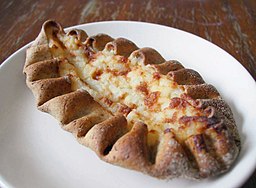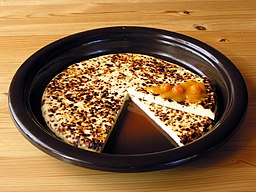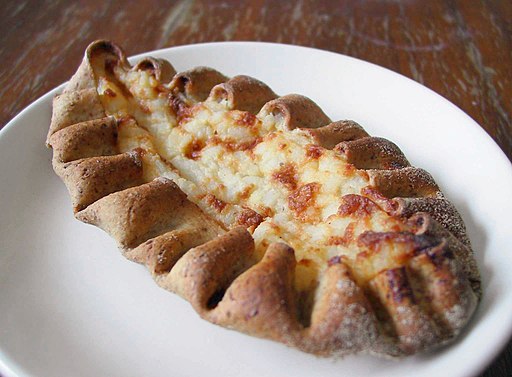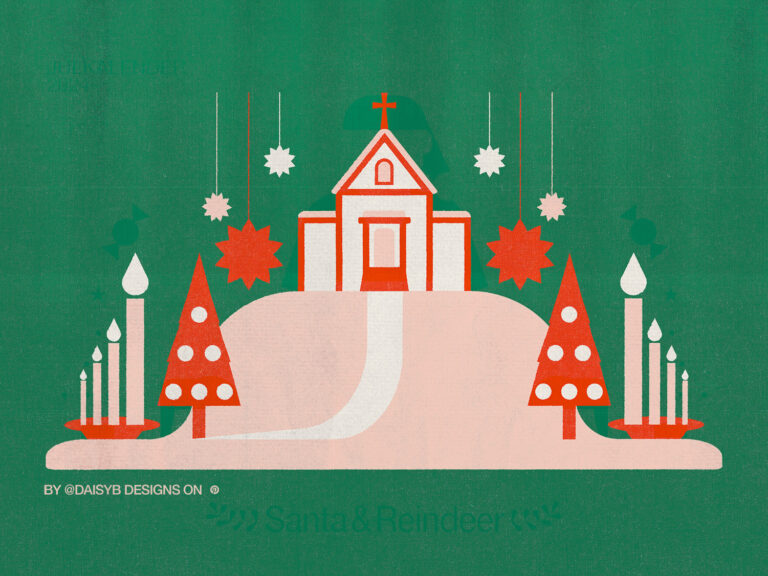By June Pelo.
Historically the western part of Finland belonged to the Roman-Catholic and Lutheran sphere of influence and via them to that of the Germanic culture.
The eastern part of Finland has been influenced by the Slavic culture of the northwest and the Orthodox tradition.
One of the typical examples of differences between the east and west is bread. At one time one could draw a “bread and buttermilk line” through Finland:
- In the west bread was thin, hard and long-lasting, baked only a couple times a year in large quantities. In some places, bread was still baked in external ovens as late as the 20th century. The buttermilk was long and stretchy.
- In the east the oven was heated nearly every day and bread was baked daily and it was soft and fresh. The buttermilk was more clotted.
Because southwest Finland was once influenced by the Roman Catholic church, fasting was important. Until recently the traditional food of Memma (Finnish = Mämmi) was eaten only in this region during Easter. It was a dark brown malt pudding served with cream and sugar.

Memma
Attribution: No machine-readable author provided.
Strangnet assumed (based on copyright claims),
CC BY-SA 3.0 via Wikimedia Commons
One of the symbols of food in eastern Finland is the Karelian pasty which originally was a specialty for holy- and feast-day celebrations.

Karelian pasty
Attribution: Jarno Elonen, Public domain, via Wikimedia Commons
Another eastern tradition is baked fish loaf. The fish is enclosed with fatty pork in a rye dough crust. The tradition reaches into Russia. Many of the traditional foods are now made commercially and seldom are the original versions.
Ostrobothnia, on the west coast, is famous for its bread cheese. In olden days milk was preserved for the winter in the form of cheese. The whey was pressed into a round flat cake on a special board and set to cook before a fire. The cheese was cut up into a coffee cup and coffee was poured on top. After drinking the coffee, the pieces of cheese were then eaten. This delicacy is now made commercially and sold around the country.

Leipäjuusto or Squeeky cheese
Attribution: Teemu Rajala, CC BY-SA 3.0
via Wikimedia Commons
Fresh milk was only for children and the sick. Soured milk was made for drinking in the winter when the cows were not milking.
Drinking spirits has been a part of the diet since the 17th century. It was first used as a medicine, then as a festival drink, and now as an intoxicating liquor. Finland is considered to be a beer-drinking nation. A specialty is a folk malt drink, sahti. Its preparation is based on a medieval tradition and is linked to the German tradition of beer making. Sahti is strong or weak, depending on whether it is served to men or to women. During the 19th century the foods of the gentry and townsfolk were adopted by the common people.
Coffee began to replace liquor, wheat was used for coffee breads and pastries and more vegetables were used.
Today the people in Finland no longer know what Finnish food is. People in the country know about pizza, pasta and burgers, as well as townsfolk. But there are a few food combinations that continue to exist, such as:
- coffee with buns
- pea soup with baked pancakes
- pancakes with jam
- sausage with mustard
- new potatoes with Pickled Baltic herring
- Karelian pasties with egg and butter mix
- crayfish with dill
- cloudberries with baked milk
Along the roadside in various parishes one can buy hot smoked fish, pizza, pea soup, fresh bread, jam and pancakes, reindeer meat in Lapland and black sausage in the Tampere area. Stores sell prepared foods, sliced bread (dark bread is preferred), low-fat versions of dairy products, and packaged meats.
Cooks who want to choose meat for themselves have to go to specialty butcher shops.
- Pork is cheap and chicken has been popular since the 1960s. It competes with ring sausage, the number one Finnish food. On sauna evenings sausages are grilled and eaten with mustard and potato salad.
- Fish consumption is increasing and includes salmon, Baltic herring, pike, whitefish and perch.
- Smoked products are basic foodstuffs such as fish, pork, lamb and sausages.
The quality of coffee is of great importance. In earlier times coffee and seven sorts of pastries were offered at family festivities. They have now been replaced by pies, salads and savories. Home-brewed beer or wine is served first, then coffee and sweet items. Sweet coffee bread is part of the tradition. Coffee parties are like miniature dinner parties.
There aren’t many restaurants offering purely Finnish food. Most offer an international menu, but some also have a Finnish menu with local dishes.
Reindeer
The reindeer is a way of life in Lapland. It’s used as a pack animal and is also a tourist attraction. Its skin is made into boots and furs. The horns are made into souvenirs. The reindeer are the Lapp’s cattle. Its meat is rich in nutrients but has a gamy taste. The Lapp serves smoked reindeer roast in thin slices as an appetizer and on sandwiches. They make paté from the tongue. But the most famous dish is Reindeer stew/Renskav/Poronkäristys reindeer stew which is served over mashed potatoes, seasoned with butter and onions and lingonberry purée. There are reindeer cutlets, steaks, meatballs, liver which is combined with rice and raisins in a casserole.
Smörgåsbord
The Smörgåsbord is a banquet. In olden times when there was a banquet, a special buffet was filled with food for the guests. The banquets lasted for days, sometimes as long as a week, and were held on major holidays, at weddings and funerals. Food preparation began a week ahead of time. A calf was slaughtered and perhaps a sheep.
To begin with there was the buffet which might have:
- a salad
- head cheese
- salted whitefish
- herring
- cold steamed fish
- smoked meat
- home-made cheese
- rutabaga, potato and liver casseroles
- various types of bread
After the guests had their fill of the buffet there was a ‘between-course snack’:
- bouillon and puff pasties
- or fruit soup made with raisins
- or mixed fruit and garnished with whipped cream
Then came the main course which could be:
- roast meat
- gravy
- boiled potatoes
- lingonberry purée
And for dessert there was:
- rice porridge
- or prune fool
- and perhaps layer cakes and pastries
The beverage was home-made beer.
Modern Smörgåsbord
This tradition gave birth to the modern smörgåsbord which has changed over the decades. Some restaurants always have a cold buffet, while others may have one once a week. The buffets on ships that sail between Finland and Sweden and between Finland and Germany give a good idea of what people want in a buffet these days. There are no two identical smörgåsbord tables, but around the world it is known as a Scandinavian specialty. The basic ingredients come from the sea, the lakes, forest, and fields. In addition to fish and meat there should be salads, snacks, bread and butter and cheese.
The first phase which starts with fish is the most important. You’ll find:
- Russian herring
- Glass master’s herring
- salted vendace
- Baltic herring rolls
- cobbler’s salmon
- smoked Baltic herring
- fresh-salted Baltic salmon
- grilled lamprey
- boiled salmon fin
- smoked whitefish
- roe
- anchovies
- shrimp
- smoked eel
- bream
- pike perch
- rainbow trout in aspic
- sardines
- mackerel
Along with the fish, there are:
- hot potatoes
- preferably a glass of cold schnapps
After the fish, there’s meat such as:
- ham
- various kinds of sliced sausage
- roast beef
- reindeer tongue
- smoked mutton
- head cheese
- paté
- cold little meatballs
- roast veal
- pig’s trotters
- tongue
Some restaurants also serve:
- turkey
- pheasant
- chicken
- wild duck
One can then lighten up a bit and have:
- herring salad
- tomato and onion salad
- Italian salad
- cucumber salad
- pickles
- chicken salad
- beets
- white or red cabbage
- potato salad
- mushroom salad
- fish salad
- radishes
There will also be a cheese tray with:
- emmenthal
- camembert
- roquefort
- Finnish country cheese
- tilsit
- crackers and crispbread of all types
- pears
- apples
- grapes
This, of course, was just the appetizer and after the buffet comes the main course which would include:
- Karelian stew
- chicken
- roast veal
- reindeer stew
- breaded veal cutlet
- omelet
- some type of a casserole – potato, carrot, rutabaga
- Baltic herring and potato
- salmon
- macaroni
And the hostess would say: “Var så god!”





